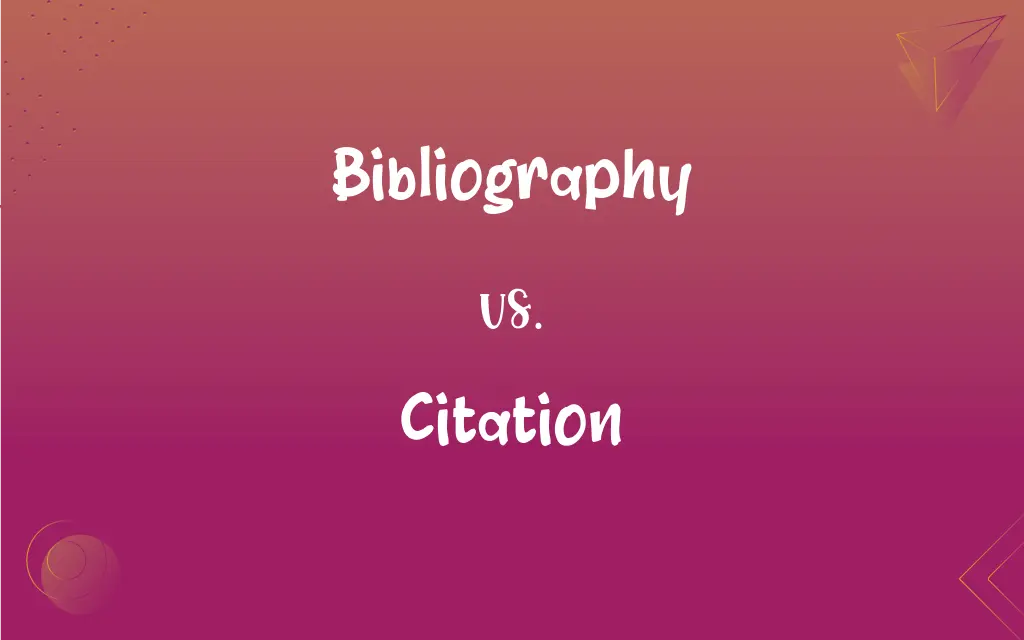Bibliography vs. Citation: What's the Difference?
Edited by Janet White || By Harlon Moss || Published on December 9, 2023
A bibliography is a list of all sources referenced in a work, while a citation is an individual reference to a specific source within the text.

Key Differences
A bibliography is a comprehensive list of books, articles, and other sources used or referenced in a piece of writing. It typically appears at the end of a document, providing full details of each source, including author, title, publisher, and date of publication. In contrast, a citation is a specific mention within the text that references a source, often accompanied by a brief detail like author's name and publication year, directing the reader to the fuller details in the bibliography.
The purpose of a bibliography is to give readers a complete overview of the sources the author consulted or referenced, ensuring acknowledgment of others' work and providing readers with additional resources. A citation, however, serves to credit a specific idea, fact, or quotation included in the text to its original source, often as a means of avoiding plagiarism and allowing readers to verify the information.
In format, bibliographies often follow specific styles like APA, MLA, or Chicago, with each entry providing comprehensive details about each source. Citations, while also adhering to these styles, appear in the body of the text or in footnotes/endnotes, and are usually shorter, often including just the author's last name and the publication year, or a page number if a direct quote is used.
A bibliography includes all works consulted during the research process, regardless of whether they were specifically cited in the text,while a citation directly corresponds to a specific source that directly influenced or contributed to the point being made in the text.
Bibliographies and citations are integral parts of academic writing. The bibliography demonstrates the depth and breadth of one's research, while citations ensure transparency and accountability in representing one's sources and contributions to a topic.
ADVERTISEMENT
Comparison Chart
Purpose
Lists all sources used or referenced.
References a specific source in the text.
Location
Usually at the end of a document.
Within the text or in footnotes/endnotes.
Content Detail
Full details of each source.
Brief details, often just author and year.
Relation to Text
Includes all consulted sources, cited or not.
Directly corresponds to material used in the text.
Role in Academic Writing
Shows research depth and scope.
Ensures accountability and avoids plagiarism.
ADVERTISEMENT
Bibliography and Citation Definitions
Bibliography
Compilation of books, articles, and other materials consulted.
He added several new entries to his project's bibliography.
Citation
A reference to a source in the body of a text.
She included a citation for every quote she used.
Bibliography
A list of sources at the end of a document.
Her research paper included an extensive bibliography.
Citation
In-text mention of a source, usually in a specific format.
The citation style used in the article was APA.
Bibliography
Collection of references used in a piece of writing.
The bibliography covered all relevant literature on the topic.
Citation
A part of text identifying the source of quotations or ideas.
To avoid plagiarism, he carefully checked every citation.
Bibliography
A section providing source details in academic writing.
For further reading, refer to the bibliography at the end of the book.
Citation
A method of crediting original ideas or words.
Each citation in her essay was meticulously formatted.
Bibliography
A systematic list of books and articles for research.
The thesis' bibliography included various interdisciplinary sources.
Citation
A note acknowledging a source of information.
His paper had a citation for each statistical data point.
Bibliography
A list of the works of a specific author or publisher.
Citation
The act of citing.
Bibliography
A list of writings relating to a given subject
A bibliography of Latin American history.
Citation
A quotation of or explicit reference to a source for substantiation, as in a scholarly paper.
FAQs
What details does a bibliography include?
Full details of each source, like author, title, and publication date.
What is a bibliography?
A list of all sources referenced or consulted in a document.
How does a citation appear in a document?
Within the text or as a footnote/endnote.
What is a citation?
A reference within the text to a specific source.
Do bibliographies follow a specific format?
Yes, like APA, MLA, or Chicago styles.
Can a citation refer to an online source?
Yes, online sources can and should be cited.
What's the purpose of a bibliography in academic writing?
To demonstrate the extent of research and provide additional resources.
Why are citations important in academic texts?
To attribute ideas and information to their original sources.
Are citations uniform in format?
They follow the specific formatting rules of the chosen style guide.
Where is a bibliography located?
At the end of a document.
Is a citation necessary for every source used?
Yes, for proper credit and to avoid plagiarism.
Does a bibliography only include books?
No, it can include articles, websites, and other materials.
Is it possible to have too many citations in a text?
Excessive citation can disrupt flow, but adequate citation is crucial.
Can a bibliography include sources not cited in the text?
Yes, it includes all sources consulted.
What does a citation typically include?
Author's last name and publication year, sometimes page number.
Are bibliographies required in all academic papers?
Generally, yes, to show the breadth of research.
Is a citation necessary for common knowledge?
No, common knowledge does not require citation.
Can a bibliography contain annotations?
Yes, in an annotated bibliography, each entry has a brief summary.
How does a bibliography differ from a reference list?
A bibliography includes all sources, a reference list only those cited.
Do citations contribute to the word count?
Typically, in-text citations do not, but footnotes/endnotes might.
About Author
Written by
Harlon MossHarlon is a seasoned quality moderator and accomplished content writer for Difference Wiki. An alumnus of the prestigious University of California, he earned his degree in Computer Science. Leveraging his academic background, Harlon brings a meticulous and informed perspective to his work, ensuring content accuracy and excellence.
Edited by
Janet WhiteJanet White has been an esteemed writer and blogger for Difference Wiki. Holding a Master's degree in Science and Medical Journalism from the prestigious Boston University, she has consistently demonstrated her expertise and passion for her field. When she's not immersed in her work, Janet relishes her time exercising, delving into a good book, and cherishing moments with friends and family.




































































